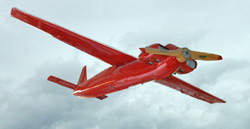Northrop 'Shelduck' Target Drone
The first large-scale production, purpose-built drone was the product of Reginald Denny. He served with the British Royal Flying Corps during World War I, and after the war emigrated to the United States to seek his fortunes in Hollywood as an actor. Denny made a name for himself as an actor, and between acting jobs, he pursued his interest in radio control model aircraft in the 1930s. He and his business partners formed Reginald Denny Industries and opened a model plane shop in 1934 on Hollywood Boulevard .
The shop evolved into the Radioplane Company. Denny believed that low-cost RC aircraft would be very useful for training anti-aircraft gunners, and in 1935 he demonstrated a prototype target drone, the RP-1, to the US Army. Denny then bought a design from Walter Righter in 1938 and began marketing it to hobbyists as the Dennymite, and demonstrated it to the Army as the RP-2, and after modifications as the RP-3 and RP-4 in 1939. In 1940, Denny and his partners won an Army contract for their radio controlled RP-4, which became the OQ-2 Radioplane. They manufactured nearly fifteen thousand drones for the army during World War II. In 1952, Radioplane Co. became the Radioplane Division of Northrop Aircraft, Inc.
The ultimate result of this evolution is the MQM-36 (originally KD2R-5) Shelduck gunnery target. Design of the Shelduck began in 1946, with first flight in 1947. The Shelduck can carry radar enhancement devices on its wingtips. Over 60,000 Shelducks were built in all, and the type has been used by at least 18 nations internationally.
Historical Note:
When we think of Marilyn Monroe, we think of a seductive superstar of the 1950-60s. Born Norma Jeane Mortenson, this forever famous actress and model's career came to be from her time working in an airplane factory.
In late 1944, Marilyn Monroe was working in a Radioplane factory to help with the war efforts during WWII. Primarily producing drones, Radioplane Company had a great influence during the second World War. Monroe's main job at the factory was spraying planes with fire retardant. While working, Monroe met a photographer from First Motion Picture Unit, which led to a successful pin-up career.
Aviation Oil Outlet (aviationoiloutlet.com)

Technical Details:
Engine: 95 hp McCulloch four-cylinder horizontally opposed
Maximum speed: 200 kt (370 km/h)
Empty weight: 271 lb (123 kg)
Launch weight: 360 lb (163 kg)
Span: 11 ft 6 in (3.5 m)
Length: 12 ft 8 in (3.85 m)
Height: 2 ft 6 in (0.76 m)
Service ceiling: 23,000 ft (7,000 m)
Endurance: 1 hour
Launch scheme: RATO booster or bungee catapult.
Recovery scheme: Parachute.
Guidance system: Radio control.
(Photo credit: Stan Walter)
(Info credit: Greg Goebel)
